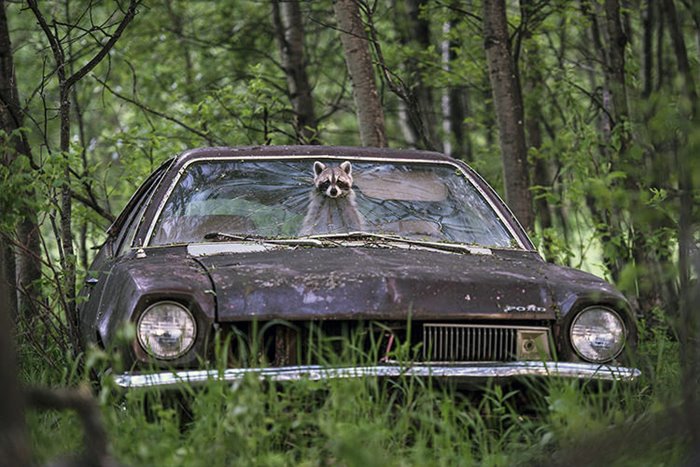The best wildlife photos of 2019
Every Year, Photography Enthusiasts Eagerly Await The Arrival Of The Best Wildlife Photo Competition To See Which Image Will Win The Title Of Best Wildlife Photo.
In addition to being the focus of a wide range of professional and amateur photography enthusiasts, wildlife photography has attracted many audiences among ordinary people. This field of photography, because it can be a comprehensive, influential, and powerful media, has been especially noticed by environmental activists and those concerned in this field in recent years. No matter which category of people you belong to, you regular readers of us, we hope you will enjoy watching the fantastic images of this article and discovering the audible story of these photos.
The competition’s 2019 prize went to a photograph titled “The Moment,” captured by a Chinese photographer named Yongqing Bao, which shows a stunning image of a ferret next to a fox.
In this article, we will review the top 35 photos of this competition (click on them to view the images in their original dimensions).
1. the moment

Yongqing Bao ()
A mother Tibetan fox, hunting to feed her three fox cubs, surprises a Himalayan ferret that has just woken up from hibernation. The Chinese photographer recorded the moment of the fox’s attack and the lightning reaction of the mouse. The strength is visible in the sharp teeth of the hunter and the terror in the face of the hunted, and you can see the unequal struggle for life and death in their faces.
The Himalayan ferret is one of the few mammals that can live in such high altitudes, and escape from the bone-chilling cold of these regions; it depends heavily on its furry skin. In the winter, the marmot spends more than six months with its prominent family members in tunnels that it has dug deep in the ground masterfully and usually does not come out of these tunnels until the beginning of spring. Spring is a treasure that hungry hunters don’t pass up easily.
2. beeline
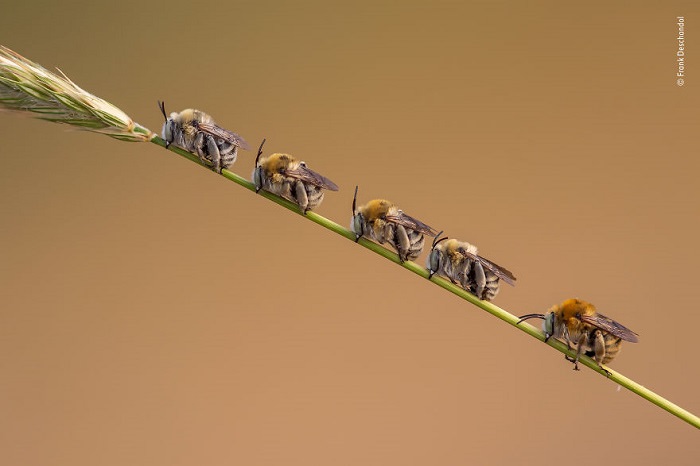
Frank Deschandol (France)
On the eve of sunset, the bees are flying by the lake, but luckily for the photographer, these five bees are resting on the stem of a plant. These solitary bees, likely males, have gone to sleep while the female bees sleep in the warm, soft hive nearby.
Cold-blooded creatures such as bees, whose body heat is provided by the sun’s heat, cannot fly at night or during bad weather conditions and are forced to rest. So they grip the stem with their powerful saw-like jaws and rest their wings. Then they gather their tiny bodies and bend their tentacles, slowly falling asleep and waiting for the next day’s sunrise.
3. eagle land
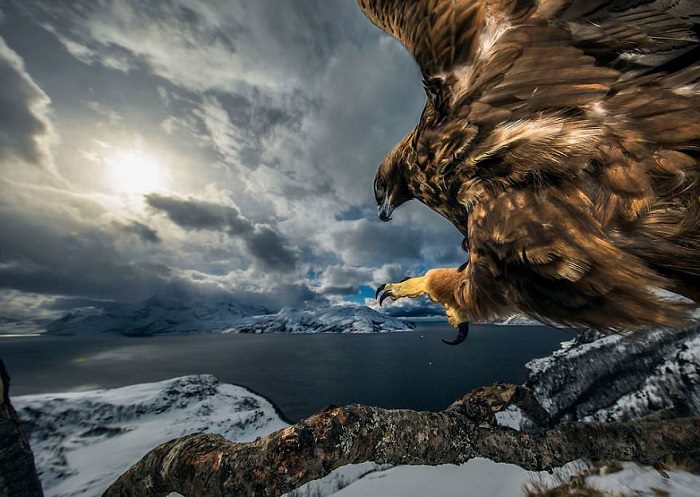
Audun Rikardsen (Norway)
The Norwegian photographer had carefully placed this tree branch here, hoping to use it to photograph the golden eagle. He set up a camera trap on the unit and occasionally placed the carcasses of road-killed animals nearby. Over the past three years, the golden eagle gradually came to trust the department and spent more time perched on it to survey its coastal territory. Finally, this incredible photo was recorded. The eagle is descending with its powerful talons outstretched.
Golden eagles usually fly at a speed of 50 km/h but sometimes reach a speed of 320 km/h when diving to hunt. Combining incredible speed with these powerful talons makes the golden eagle a deadly predator. Typically, mammals, reptiles, small birds, and all kinds of fish make up the golden eagle’s food, but sometimes it eats larger animals and the carcasses of dead animals.
4. The gate of happiness

Jason Bantle (Canada)
A raccoon peeks out from a hole in the windshield of an abandoned car, allowing a photographer to capture it at dusk. The gap created in the glass only will enable raccoons to pass through and is not large enough for predators like coyotes to enter; The same thing has turned the car’s back seat into a warm and soft nest for the raccoon and his five little ones. Raccoons usually prefer to nest in hollow trees or rock crevices but can quickly adapt to new conditions. Raccoons are opportunistic animals and will eat everything from fruit and nuts to the contents of trash cans. As soon as the sun goes down, this mother raccoon will leave her nest to search for food all night to feed herself and her babies.
5. A portrait of a mother

Ingo Arndt (Germany)
Tracking a puma (American cheetah) requires carrying heavy equipment in the worst weather conditions, such as strong winds and bone-chilling cold. Finally, with a lot of effort, he gained the respect and trust of the mother, puma, and took a photo of this family. According to the photographer of this picture, there is nothing more exciting than catching sight of a wild puma. Cougars maintain this childlike playfulness throughout their lives. Cougars fight with each other, and with the help of these games, they learn essential life skills such as hunting, fighting, and running away. Before becoming independent, the cubs usually live with their mother until they are two years old, and then they are alone until it is time for them to reproduce.
6. Cold drink
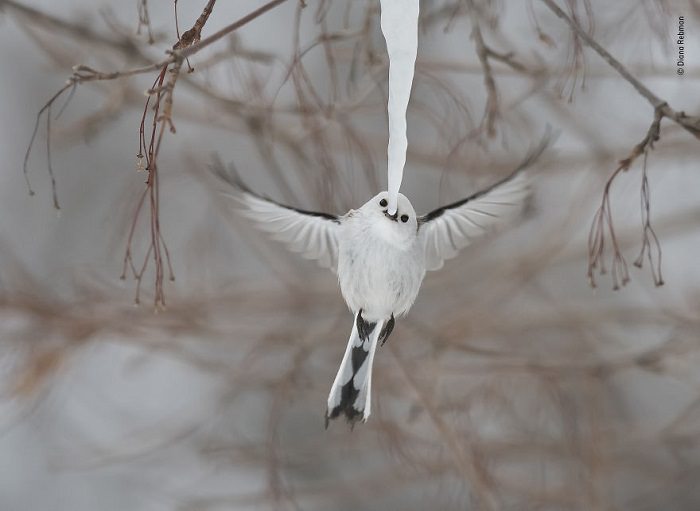
Diana Rebman (USA)
Despite the extreme cold of minus 20 degrees Celsius, the American photographer spends hours watching the long-tailed teats take turns pecking at this ice jellyfish, Which he compares to dance practice. It is clear that due to the fast movement of these birds and the frozen fingers of the photographer, it was challenging to capture the image. Long-tailed tit lives throughout Europe and Asia. Residents of Hokkaido, Japan, have given them the name Shima-Enga. These beautiful birds have to use snow and ice in the cold and snowy winters of the region to provide the water they need. They search for food all day and hunt insects and spiders, and at night they gather together in several groups to stay safe from the cold weather.
7. Snow landing
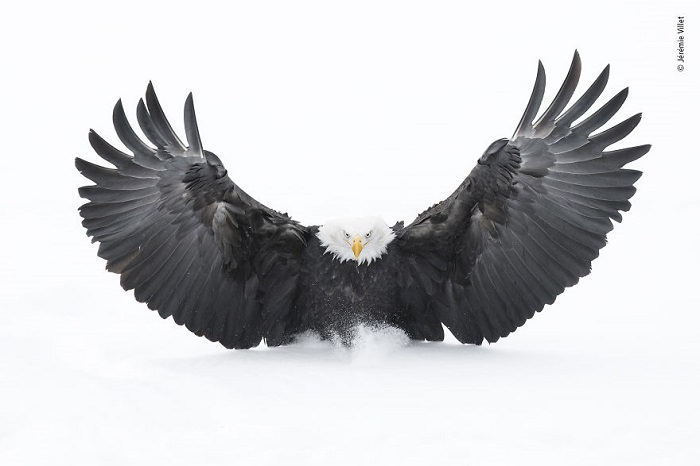
Jérémie Villet (France)
Image of a bald eagle landing on a snowy river with outstretched wings and eyes staring down at the victim. The photographer watched these birds’ movements for nearly a week from his hiding place. He had an excellent positioning in that he successfully captured the eagle diving to catch salmon from the almost frozen water of the river and created this wonderful portrait. Salmon, please return to the estuaries of their original habitat to spawn, which is an integral part of their life cycle. Salmon die shortly after spawning, a time of abundance for opportunistic eagles. This event draws nearly 3,000 bald eagles to the Chilcot River in Alaska yearly, so they don’t miss out on the salmon hunting feast.
8. Snow show

Max Waugh (USA)
In the snow and blizzard of winter, an American bison raises its head as it searches fruitlessly for forage. The photographer deliberately slows down the camera’s shutter speed so that the snowfall appears opaque and creates a ghostly image of the buffalo. By slightly overexposing the photo and turning it into a black-and-white image, the photographer has emphasized the simplicity of this winter image. In winter, buffaloes constantly shake their big heads and shovel the snow with their snouts to find fodder. Indiscriminate hunting for the meat and skin of the American buffalo brought this creature to the brink of extinction in the 19th century. Still, fortunately, their number has increased, and this animal is protected in American national parks.
9. cradle of life
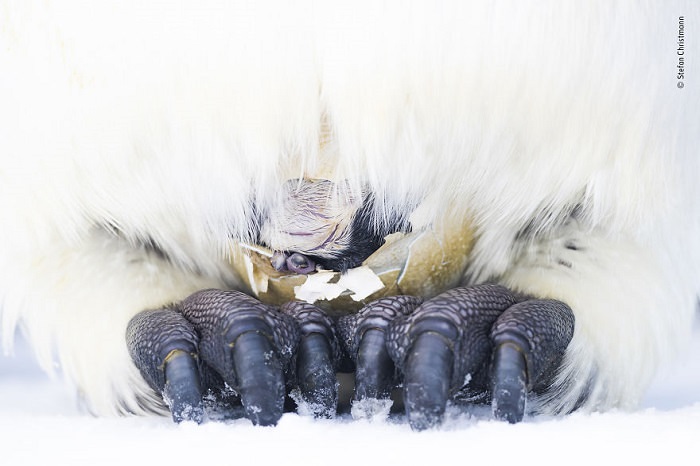
Stefan Christmann (Germany)
The photographer of this picture says: “Taking a picture of an emperor penguin chick when it hatches is not a difficult task because the male penguin keeps lifting the pouch to check the condition of the egg. The hard part is finding a penguin standing in the right direction and having the right light for photography at this critical moment. When female penguins are at sea hunting for fish, their mates endure the harsh polar winter with great hardship as they have to take care of the eggs without food. After 65 to 75 hard and grueling days, the chicks finally hatch.” In this picture, you can see a penguin chick that looks tired and struggles to break its egg with its eyes closed.
10. sky hatch

Sven Začek (Estonia)
The photographer has placed his drone directly above the lake to capture the reflection of the sunlight in the lake’s mirror as soon as the sun comes out from behind the clouds. He claims he had technical problems and lacked a battery while taking this photo. But it seems that the photographer’s patience has not gone unrewarded; Because it has caught this beautiful sky landscape that is not unlike the human eye. Karola National Park in the Republic of Estonia is home to various species of bison, wolves, bears, and lynxes, and the felled trees by the lake indicate that the population of water dogs in Karola Park is increasing. Their incredible skill in building dams causes the lake’s water level to rise and the water to flow into the forest, and the loosening of the soil and the damage of the roots prevent the growth of trees on the shore of the lake.
11. If penguins could fly
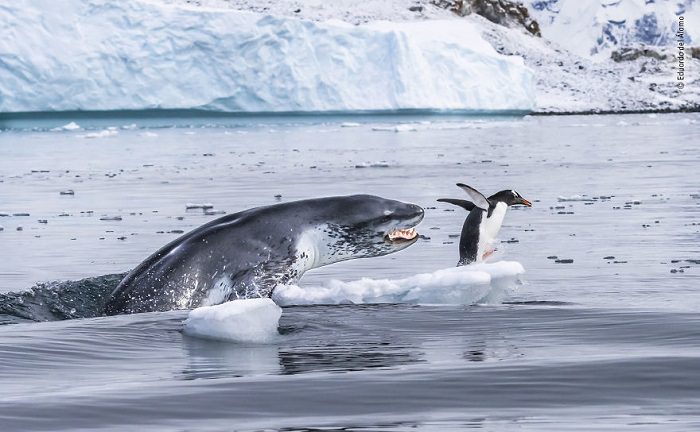
Eduardo Del Álamo (Spain)
The image shows a gentoo penguin escaping from a sudden attack by a leopard seal. The penguin was resting on a piece of ice when he saw the seal. A few moments later, the seal jumped out of the water with its mouth open to hunt the penguin. The photographer of this picture says: “I was anticipating such a moment.
Leopard seals are predatory predators. Their long, slender bodies are built for fast swimming and have powerful jaws and long, canine-like teeth. Seals hunt almost anything; their diet can change depending on the seasons and food availability. The leading food is penguins, but they also hunt squid, shrimp, fish, and even baby seals.
12. Congestion
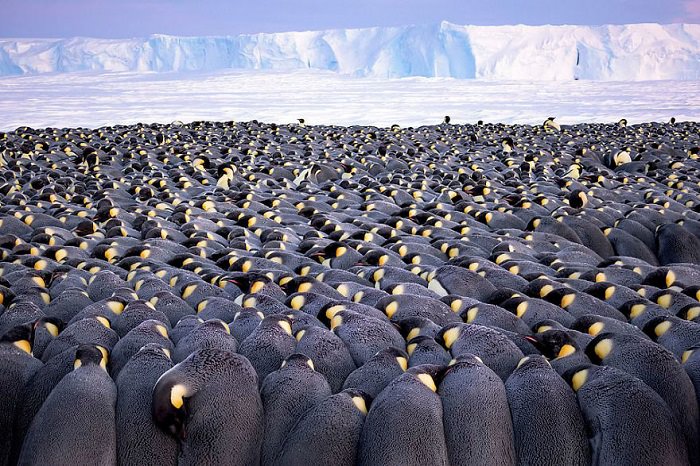
Stefan Christmann (Germany)
More than 5,000 male penguins stand with their backs to the wind on a frozen sea, hugging each other and lowering their heads to share body heat. “It looked like a calm day, but when I took off my gloves to focus, the cold went through my fingertips like needles,” says the photographer of this image.
Antarctica has cruel winters, and the temperature sometimes reaches minus 40 degrees Celsius. When female penguins spend about two months at sea hunting for fish, their mates take care of the eggs. The male penguin carries and keeps the egg on his feet like a precious cargo, and to protect the eggs from the cold and stay warm, a layer of penguin skin covers it like a warm blanket. The penguins exposed to the wind in the outer layer of this immense ring move slowly and take refuge in the warm inner layers, and in this way, they all benefit from the warmth of the center of this ring, and with this intelligent partnership, they save their lives.
13. freezing moment

Jérémie Villet (France)
Two male white antelopes pause during a fierce battle, their thick, spiraling horns intertwined. The photographer of this picture says that he has dreamed of recording such an image for years; Photography of a white mountain goat in a frame covered with snow in the Alps. To register this photo, he lays down on the snow and captures this moment despite the severe cold and strong wind blowing—a combination of power and purity.
The white antelope lives in the North Pole and the areas close to it. To survive and escape their predators, they depend strongly on steep and uneven rocks to safely graze in the pastures and meadows around them. In winter, they are interested in areas where strong winds blow away the snow and expose the plants.
14. Garden of eels
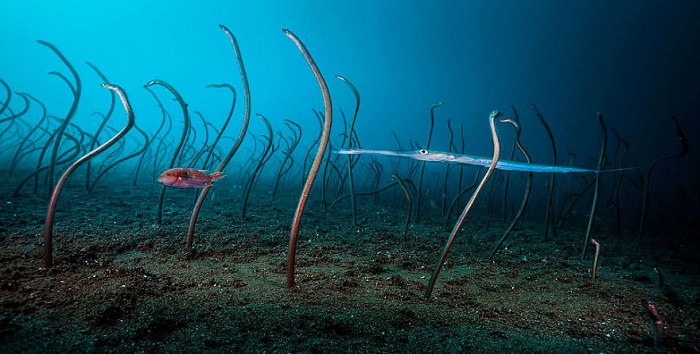
David Doubilet (USA)
A large group of eels is swirling in the water, but as soon as the photographer enters the scene, they immediately hide in the tunnels on the sea floor. For this reason, the photographer fixes his camera at this point, hides behind the remains of a wrecked ship, and records the above photo by remote control. Of course, the reappearance of the eels took several hours, and the recording of the ideal image of this photographer lasted several days. Eels feed on the plankton in the water flow, and as you can see in the picture, the presence of trumpet fish and wrasse does not bother them, but they hide in the tunnels on the sea floor as soon as they feel danger. Like many other species of fish, eels detect the movement of objects through the lateral sense organ (this sensor is stretched along the length of their body).
15. Big cats fight with dogs
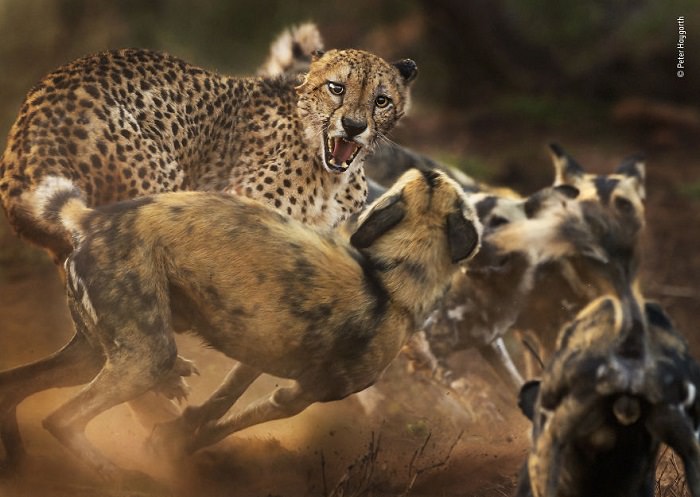
Peter Haygarth (England)
In a rare encounter, a pack of African wild dogs attacked a lone male cheetah. At first, the dogs were cautious, but as soon as their collection of 12 was complete, they became more confident and surrounded him. Cheetah, who was very scared, quickly ran away from the dogs.
Unfortunately, African wild dogs and cheetahs have rapidly disappeared from their former territories. Only less than 7,000 of them remain, and the destruction of habitats also threatens the few remaining populations. The group of African wild dogs, which once had hundreds of members, is now a Small group with only 15 members that have been converted.










